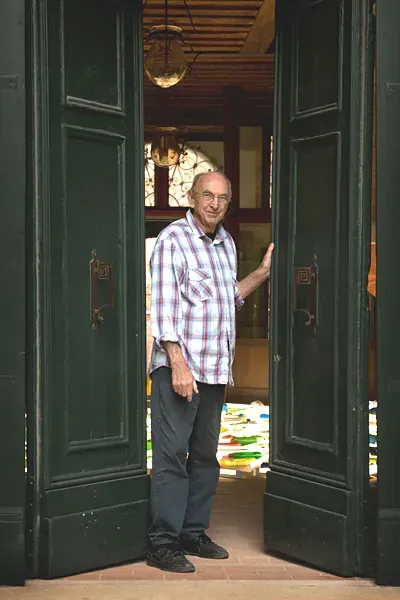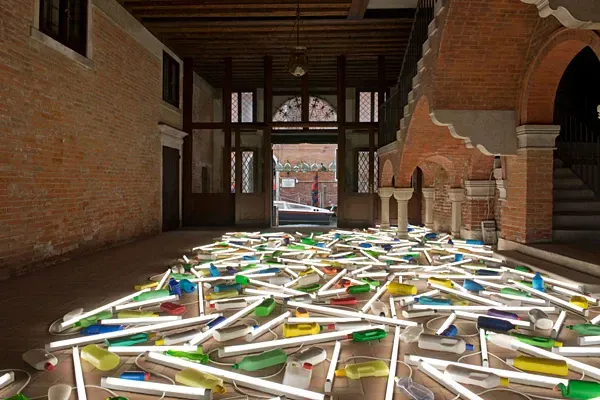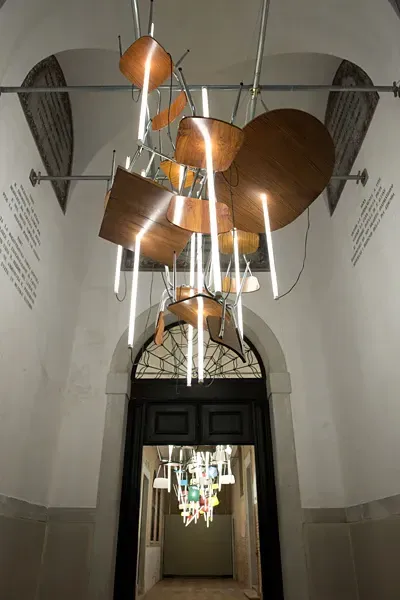NZ lights up at Venice Biennale
Written by

A huge suspended sculpture made of furniture and a floor covered with dazzling lights are just two of the works Bill Culbert has created for the New Zealand Pavilion at the 2013 Venice Biennale, which opened last night.
A huge suspended sculpture made of furniture and a floor covered with dazzling lights are just two of the works Bill Culbert has created for the New Zealand Pavilion at the 2013 Venice Biennale, which opened last night.
Culbert’s exhibition, Front Door Out Back, features eight installations using fluorescent lights and recycled domestic objects to transform the historic Istituto Santa Maria della Pieta (La Pieta) building on the busy thoroughfare between San Marco and the Giardini.
Bill Culbert is a pioneer of the use of electric light in art and has been making works that harness its qualities since the 1960s.
“The ultimate experience comes when you stand in the space to enjoy the dazzle and play of light and the journey,’’ he says of his Venice Biennale exhibition.
The Venice Biennale is the most prestigious contemporary visual arts exhibition in the world with more than 80 countries taking part.
“Combining light and things with rare economy, Culbert produces art that is austere, poetic and challenging in the way it invites us to revalue familiar things and focus our perceptions,” says New Zealand’s Commissioner for the 2013 Venice Biennale, Jenny Harper.
“Step into Bill Culbert’s Front Door Out Back and you enter a living space of an unusual kind, a sculptural meditation, played out through eight connected spaces, on shelter, habitation and dwelling,” says exhibition curator, Justin Paton.
“On arrival the visitor is confronted with Bebop, a 15-metre-long work suspended from the ceiling of the historic corridor, where 34 second-hand tables and chairs seem to have been lifted and spun through the space, each one pierced by a single bolt of fluorescent light. In another key work, Daylight Flotsam Venice, Culbert feeds 150 fluorescent tubes into a densely packed field of recycled plastic bottles creating a carpet of colour, seen against the backdrop of the canal beyond.”
Creative New Zealand funds and leads New Zealand’s presence at the Venice Biennale. Creative New Zealand acknowledges the support of the Museum of New Zealand Te Papa Tongarewa, Christchurch Art Gallery Te Puna o Waiwhetu and Massey University in the realisation of the 2013 exhibition.
More information on New Zealand’s exhibition at 2013 Venice Biennale
The 2013 Venice Biennale opens on 1 June and runs until 24 November.
Background: New Zealand at the 2013 Venice Biennale
Commissioner: Jenny Harper, Director, Christchurch Art Gallery Te Puna o Waiwhetu
Deputy Commissioner: Heather Galbraith, Head of the School of Art, College of Creative Arts Toi Rauwharangi, Massey University, New Zealand
Curator: Justin Paton, Senior Curator, Christchurch Art Gallery Te Puna o Waiwhetu.
Artist: Bill Culbert
Born in Port Chalmers in 1935, Bill Culbert lived in New Zealand until 1957, when he received a scholarship to study at the Royal College of Art in London. Having emerged to acclaim as a painter in the 1960s, he then began to experiment with the electrical light, which remains at the heart of his practice today. Culbert lives and works in London and Croagnes, France, returning to New Zealand regularly. He has had more than 100 solo exhibitions and been included in group exhibitions around the world. He is also renowned for a number of public commissions, several in collaboration with his friend and fellow artist, the late Ralph Hotere. He was awarded an honorary Doctorate in Fine Arts by the University of Canterbury in April 2013.
New Zealand at the Venice Biennale: past years
New Zealand has shown at the Venice Biennale since 2001, with exhibitions by Peter Robinson and Jacqueline Fraser (2001), Michael Stevenson (2003), et al. (2005), Judy Millar and Francis Upritchard (2009), and Michael Parekowhai (2011). The Biennale is widely recognised as the world’s pre-eminent contemporary art exhibition, with more than 80 countries taking part. It attracts more than 30,000 key international curators, critics, collectors and artists to the three-day Vernissage (preview) period alone.
Media Release: Creative New Zealand

